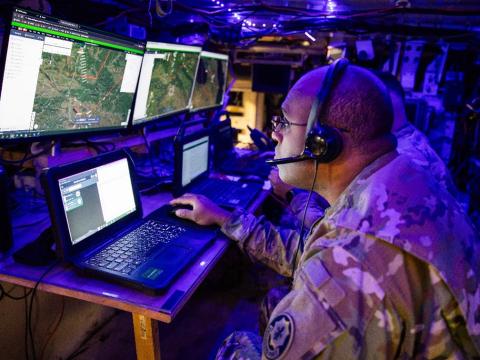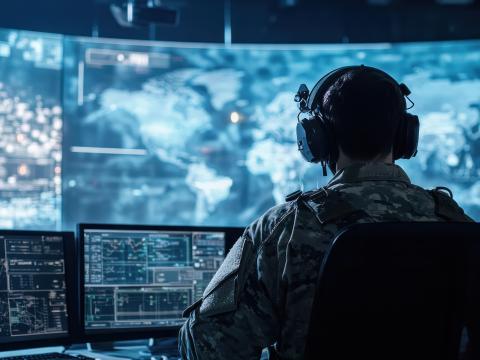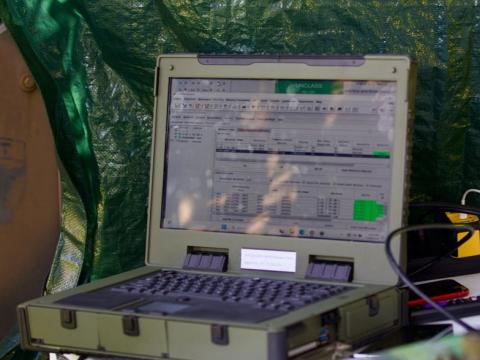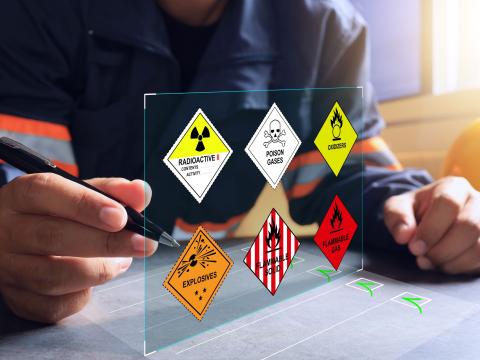Integration Is C5ISR Center's Core Calling
The Integrated Tactical Network is the name of the Army’s envisioned future network, and integration is the name of the game for one of the service’s premier research and development centers.
The mission for the newly named Command, Control, Communications, Computers, Cyber, Intelligence, Surveillance and Reconnaissance (C5ISR) Center remains largely the same, but seamless integration of those eight closely related technology areas is now a primary focus, according to Michael Monteleone, who directs the C5ISR Center’s Space and Terrestrial Communications Directorate.
“The biggest change right now is that we are incredibly focused on the integrated capabilities across the traditional functional areas and really looking at multidomain operations,” Monteleone offers. “When I say integration, that’s what I mean. If I’m going to deliver a solution that helps enable long-range precision fires—the Army’s number one modernization priority—I’m bringing to bear the best of my sensor capabilities, the best of my intelligence capabilities, the best of my cyber capabilities, the best of my electronic warfare capabilities, the best of my communications capabilities.”
Seamless integration of C5ISR capabilities will help enable the future Integrated Tactical Network, commonly known as the ITN. Maj. Gen. David Bassett, USA, program executive officer for Command, Control, Communications–Tactical, and Maj. Gen. Peter Gallagher, USA, director, Network Cross–Functional Team, are overseeing ITN development and have an iterative plan to bring together network transport, mission command applications and services, all easily deployed to soldiers.
The plan includes four lines of effort: developing a unified network, creating a common operating environment, improving joint and coalition interoperability and improving the mobility and survivability of Army command posts. “We know that the things that we are doing today are going to develop capabilities that are going to have a significant improvement in our expeditionary capability, and also in the simplicity of the network design,” according to Gen. Gallagher.
Monteleone cites multiple efforts in the communications realm that will help the Army to realize its vision. Army officials intend to use newly available ground station capabilities that allow greater capacity or security from existing satellites to enhance satellite communications (SATCOM) for future warfighters.
“Even though I can’t go into deep detail on this, the key takeaway is the military invests incredible amounts of money in military communications satellites. Satellites when they launch are meant to be up there for decades or more, and we rely on them for a period of time,” he says. “The more we learn about those satellites, we learn there are additional capabilities that we can take advantage of.”
Those capabilities largely are discovered through advances in ground station software. “As technology advances, particularly in the ground segment that interacts with the satellites, we are finding that you can get more out of those satellites. It’s not that it has a feature we didn’t know about. It’s that you can do more with the capability that was there,” he explains. “I can get more capacity, or the trade-off is that I can add more protection against enemy interference or interference in general.”
The new capabilities could also be incorporated into future satellite systems, some fairly soon, he adds. “We are exploring and have already found some incredible capabilities we can incorporate into future systems and probably fairly near-term future systems that will allow us to better utilize our military SATCOM capability as well as our commercial SATCOM capability.”
Army officials also express hope they will be able to take advantage of industry plans, such as those by SpaceX and OneWeb, to launch hundreds or even thousands of small satellites for an Internet in space. “What’s really exciting to us right now is that commercial vendors, private companies, have some really neat offerings that they’re looking to put out in the next few years on orbit, including low-earth-orbit satellite constellations that allow you to have broadband Internet access beamed down to essentially a very, very small form factor,” Monteleone says. “We are very much interested and actively working on how to incorporate that into the military environment to best utilize a combination of military SATCOM and commercial SATCOM capabilities but then also make sure we have the adequate protections so that we can operate that in a military environment.”
An Internet in space could be game changing for the Army and the entire military. “Think about 1,000 of these really small satellites out there that have a communications capability, not only to the ground user but also amongst themselves. You’re peppering thousands of satellites that are constantly, every minute or minute and a half, going over your head. Each one of those is connected to the other and to the ground user,” Monteleone offers. “These companies are thinking they can provide us what we’re used to in our homes as far as wired Internet access where we have cable modems and FIOS and all these high-speed Internet connections. That’s what they’re telling us they can give us from space.”
Monteleone also touts the C5ISR Center’s Modular RF (radio frequency) program, which he describes as automating path selection for transmission signals, a process the Army calls primary, alternate, contingency and emergency (PACE). At its core, it is a process for developing a communication plan.
Automating that process would give warfighters the equivalent of modern communications in the civilian world. “Think about your cellphone. Your cellphone seamlessly switches from many different capabilities of cellular as you drive around, depending on your coverage area. It may only allow you to do voice or data or high-speed data, and then when you pull in your driveway, it automatically connects to your Wi-Fi in your house. You don’t know it’s happening, but you have seamless connectivity in order for you to do what you need to do,” he explains. “Think about that in a military environment, the complexities of where we may operate in the future and conditions under which we may need to be continuously moving.”
The program also would allow better understanding of the RF spectrum environment and enhance proactivity. “One of the most difficult problems is understanding what is going on in the environment, and then preferably not reacting to it but proactively assigning our communications paths in an automated fashion based upon those environmental conditions,” Monteleone elaborates.
The C5ISR Center also is exploring opportunities for using fifth-generation, or 5G, communications capabilities. “One of the biggest pieces from a communications perspective with 5G is the ability to incorporate very, very high frequency usage and directional usage of that spectrum, to beam high-speed data down to your edge device or your cellphone or whatever you have that is 5G enabled,” Monteleone notes. “The componentry, the technology that actually enables that, used to be incredibly expensive and incredibly hard to come by many years ago. Now, the price point has come down and the capability has increased.”
As cellphones and other wireless communications devices have proliferated, the United States and other countries around the world have begun sharing traditional military frequencies with the private sector, giving the military less spectrum for operations. But laser communications and largely unused spectrum in millimeter waves may offer some relief.
“The way we want to operate as the United States Army around the world may require having alternatives of spectrum use, particularly if we have to operate in an urban environment, a megacity, [or] any of those areas where they have a complex spectrum environment,” Monteleone states. “We’re seeing a lot of opportunities now to take advantage of capabilities that operate outside the traditional communication frequencies that we’ve been communicating with for many, many years.”





Comments